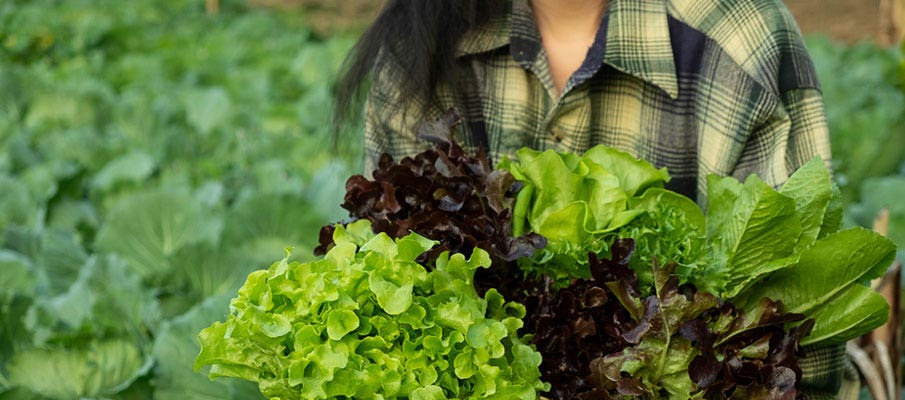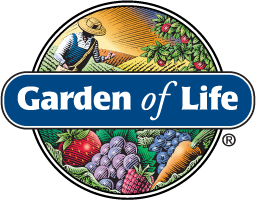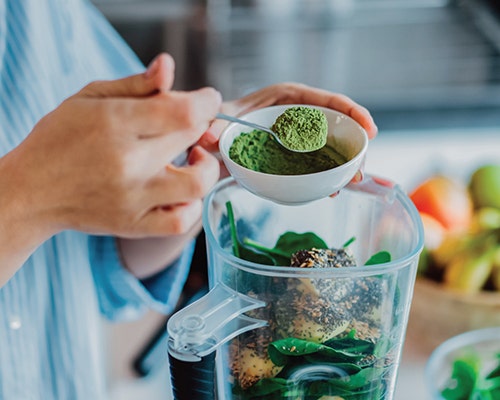Leafy Greens 101: A Deep Dive with an RD
- 5/29/23


No matter what your preferred eating style is, greens have a place. Greens are leafy green vegetables, which are considered one of the most nutrient-dense foods you can eat.
If your intake of greens is limited to spinach and lettuce, there are many more varieties to explore. We’re reviewing what makes greens great, suggesting new ones to try, and offering tips to make the most of them.
Health Benefits of Greens
Greens are nutrient-dense, meaning they contain a high amount of vitamins, minerals, and antioxidants. They’re also low in calories and high in fiber, making them an invaluable tool to support weight management and healthy digestion.
Greens contain bioactive compounds, like chlorophyll, that are linked to better health and longevity. Numerous studies have associated the intake of fresh leafy green vegetables with a decreased risk of developing chronic diseases, including heart disease, cancer, type 2 diabetes, and obesity.
Researchers have also found eating more greens can help slow cognitive decline associated with aging, support bone health, and protect vision from age-related eye diseases.
Types of Greens and How to Use Them
Because greens wilt during cooking, a serving of cooked greens has more nutrients than the same amount eaten raw. However, some greens are better suited for cooking than others. Here are seven greens to know.
Beet Greens
Beet greens are the leafy greens that grow out of beets. They’re tender with a mild, sweet flavor. They work equally well in salads or lightly sauteed.
One cup of raw beet greens provides more than enough vitamin K to satisfy the percent Daily Value (% DV), or the amount you typically need in a day. Vitamin K plays an important role in blood clotting and helps maintain strong bones.
Collard Greens
Collard greens are a hearty green and a good source of vitamins A, C, K, and folate.
Raw collards can taste bitter, although the large leaves make a good low-carb substitute for tortilla wraps. When cooked, they’re less bitter. Collards hold up to heat well, so try adding some to slow-cooked soup or stews.
Grasses
Alfalfa, barley, and wheat grasses are young green shoots from which the respective plants grow. A 1-ounce shot of wheatgrass provides 100% DV for iron and 20% for vitamin C.
Green grasses are most often grown and harvested for juicing or found in powdered form. You can find them in health food stores or purchase a kit to grow your own at home.
Kale
You’ll find several types of kale in the produce aisle, including curly, lacinato, and baby varieties. Most varieties have tough stalks that need to be removed before cooking or eating raw. Baby kale is tender and milder tasting, while mature kale can taste bitter.
Just one cup of raw kale meets your daily needs for vitamins A, C, and K. Try blanching or massaging torn kale leaves for a salad with olive oil and lemon juice to soften leaves and reduce bitterness.
Microgreens
Microgreens are seedlings, or baby plants, harvested from vegetable and herb seeds. Microgreens have a higher concentration of vitamins, minerals, and bioactive compounds than mature plants. Most varieties are a good source of vitamins A and C.
Because they’re young, the leaves of microgreens are small and tender. They’re best enjoyed fresh, so try adding them to salads, sandwiches, pizzas, tacos, eggs, and grain bowls.
Spinach
Whether you buy it by the bunch or bagged, spinach is a versatile green. Its flavor is mild when eaten raw, making it a great addition to smoothies, and it becomes sharper when cooked.
Like other greens, spinach is a good source of vitamins A, K, and C. One cup of raw spinach provides about 15% of the DV for folate, which is a B vitamin essential for healthy red blood cell production and normal fetal development during pregnancy. It’s also an excellent source of the antioxidants lutein and zeaxanthin, which support eye health.
Swiss Chard
Also called rainbow chard due to its colorful stems, this green has large leaves that are somewhat bitter raw and taste similar to spinach when cooked. The leaves can be eaten raw or cooked, but the stems are tougher and best when cooked.
One cup of cooked Swiss chard provides 477% DV for vitamin K, 60% DV for vitamin A, and 35% DV for vitamin C. It’s also a good source of minerals magnesium, potassium, copper, manganese, and iron.
Tips for Increasing Your Intake of Greens
It’s best to mix both raw and cooked greens into your diet for maximum nutrition and versatility. Here are ideas to use more greens:
- Add a handful of raw greens to blended smoothies
- Layer greens on sandwiches with other veggies
- Include a side salad with lunch and/or dinner. Choose a different green base weekly for variety.
- Add handfuls of hearty greens, such as collards, kale, spinach, and Swiss chard into soups, casseroles, and sauces.
- Most greens can be quickly sauteed in a bit of oil for a side dish. Add some garlic, a pinch of salt, and a squeeze of lemon juice for flavor.
- Add greens to homemade pesto
When life gets busy, it’s not always possible to eat a variety of greens. A greens powder can help fill in gaps in your diet. Garden of Life Perfect Food Super Green Formula contains a blend of powdered greens, so you can easily harness the nutritional benefits of assorted greens.
Takeaway
Greens are nutritional powerhouses, and a higher intake of green vegetables is associated with better overall health. With so many varieties and ways to enjoy them, greens deserve a place at the table. Challenge yourself to try a new type of green each week and consider adding a greens supplement to your daily routine.
References
-
Ojagbemi A, Okekunle AP, Olowoyo P, et al. Dietary intakes of green leafy vegetables and incidence of cardiovascular diseases. Cardiovasc J Afr. 2021;32(4):215-223. doi:10.5830/CVJA-2021-017
-
Morris MC, Wang Y, Barnes LL, Bennett DA, Dawson-Hughes B, Booth SL. Nutrients and bioactives in green leafy vegetables and cognitive decline: Prospective study. Neurology. 2018;90(3):e214-e222. doi:10.1212/WNL.0000000000004815
-
Sim M, Lewis JR, Prince RL, et al. The effects of vitamin K-rich green leafy vegetables on bone metabolism: A 4-week randomised controlled trial in middle-aged and older individuals. Bone Rep. 2020;12:100274. Published 2020 Apr 26. doi:10.1016/j.bonr.2020.100274
-
Li N, Wu X, Zhuang W, et al. Green leafy vegetable and lutein intake and multiple health outcomes. Food Chem. 2021;360:130145. doi:10.1016/j.foodchem.2021.130145
-
FoodData Central: beet greens. United States Department of Agriculture. Accessed March 22, 2023. https://fdc.nal.usda.gov/fdc-app.html#/food-details/170375/nutrients
-
Vitamin K. National Institutes of Health. Accessed March 22, 2023. https://ods.od.nih.gov/factsheets/VitaminK-Consumer/
-
FoodData Central: collard greens. United States Department of Agriculture. Accessed March 22, 2023. https://fdc.nal.usda.gov/fdc-app.html#/food-details/170406/nutrients
-
FoodData Central: organic wheatgrass shorts. United States Department of Agriculture. Accessed March 22, 2023. https://fdc.nal.usda.gov/fdc-app.html#/food-details/580819/nutrients
-
FoodData Central: kale. United States Department of Agriculture. Accessed March 22, 2023. https://fdc.nal.usda.gov/fdc-app.html#/food-details/323505/nutrients
-
Ebert AW. Sprouts and Microgreens-Novel Food Sources for Healthy Diets. Plants (Basel). 2022;11(4):571. Published 2022 Feb 21. doi:10.3390/plants11040571
-
FoodData Central: spinach. United States Department of Agriculture. Accessed March 22, 2023. https://fdc.nal.usda.gov/fdc-app.html#/food-details/168462/nutrients
-
Buscemi S, Corleo D, Di Pace F, Petroni ML, Satriano A, Marchesini G. The Effect of Lutein on Eye and Extra-Eye Health. Nutrients. 2018;10(9):1321. Published 2018 Sep 18. doi:10.3390/nu10091321
-
FoodData Central: swiss chard. United States Department of Agriculture. Accessed March 22, 2023. https://fdc.nal.usda.gov/fdc-app.html#/food-details/170401/nutrients





